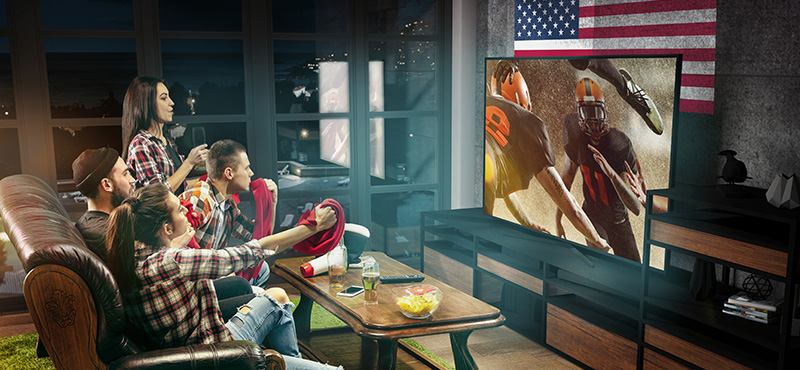It’s fall – which means one thing – football is back! Now that summer is officially over, many of us will be racing to set up the best home entertainment system possible to watch our favorite teams. But how can we create an immersive at-home experience that makes you feel like you’re at the game? And what components should we buy? 4K or 8K? How can we ensure the best value? Relax—we’ve got you covered. Here are the three most important tips from our at-home experts.
1. 8K, 4K or 1080p?
Screen technology has boomed in recent years, creating a hyper-realistic experience that brings to life tiny, on-field details – picture flying turf and dripping beads of sweat. But what is the right screen technology for you? First, it’s important to note that most sporting events are broadcast in 1080p or Full HD. Some signature games are broadcast in 4K, while a majority of On Demand programming and streaming content are available in 4K, which has four times the resolution of Full HD. There is very limited content available for 8K content, which is 4 times higher resolution than 4K – but that will change over time. For now, 4K is probably your best bet.
While investing in a 4K television is a safe bet for the future, 8K might be a bridge too far. “In my opinion, 4K is actually better than 8K because it offers a more immersive experience,” says Steven Hill, DIY pro and founder of the DIY Gazette. “8K is just too realistic and can be a little overwhelming—it feels like you’re really in the movie or TV show you’re watching.”
2. Maximizing the audio experience
When you’re watching football, you want to hear everything—from commentary to the roar of the crowd. “Most modern HDTVs can produce adequate sound, but nothing beats dedicated speakers for a truly cinematic experience,” says Bianca Trembley, founder of review site The Best of Calgary. “Consider getting a soundbar, which combines multiple speakers into a single low-profile, horizontal package, for small rooms. Some of the slimmer models can fit directly beneath the screen, while others serve as a sort of reinforced base, with the TV sitting directly on top.
The size of the room matters, too. “For optimum sound quality, choose a space at least 20 feet in length and 12 feet wide,” adds Jason Ball of Considered Content. Bell also recommends choosing a location as far as possible from other noise sources, such as the kitchen, garage, or a children’s bedroom.
When it comes to maximizing the audio experience of your home entertainment system, Maggie Atkinson, of Muffle Acoustics, offers a final reminder. “Even with the best sound system and speakers, if the acoustics are bad and the room is full of echo and reverberation, it won’t sound good,” she notes. “Investing in acoustic panels or acoustic fabric will increase sound quality and give you that engaging feeling that a conventional cinema does.”
3. Get wired
You’ve invested in a great screen and optimal audio, and you’re all set for football season, right? Well, not so fast. Before you grab your beer and claim your spot on the sofa, you need to ensure that you have the right cables to connect everything and make it all work. The key point here is to make sure your cable can pass the resolution of your audio system or high-def set-top box through to your TV screen – and getting the wrong one can make a difference.
For that reason, “you will also need an HDMI cable to connect your TV to your AV receiver or surround sound system,” notes Kamil Kowalski lof LimakWay Remodeling. “This is the connection type recommended by most streaming services like Disney+, HBO, Peacock, Netflix, and Hulu.”
Don’t forget the Wi-Fi!
Of course, today, the best home entertainment system in the world is worth very little without a Wi-Fi connection, and ensuring your TV has a strong Wi-Fi connection is key to making Game Day seamless – not stressful. All modern TVs feature online connections, allowing them to receive the latest updates from the manufacturer, in addition to accessing the streaming capabilities and channels the TV may have. For more info on extending your at-home Wi-Fi range, check out our related blog here.
